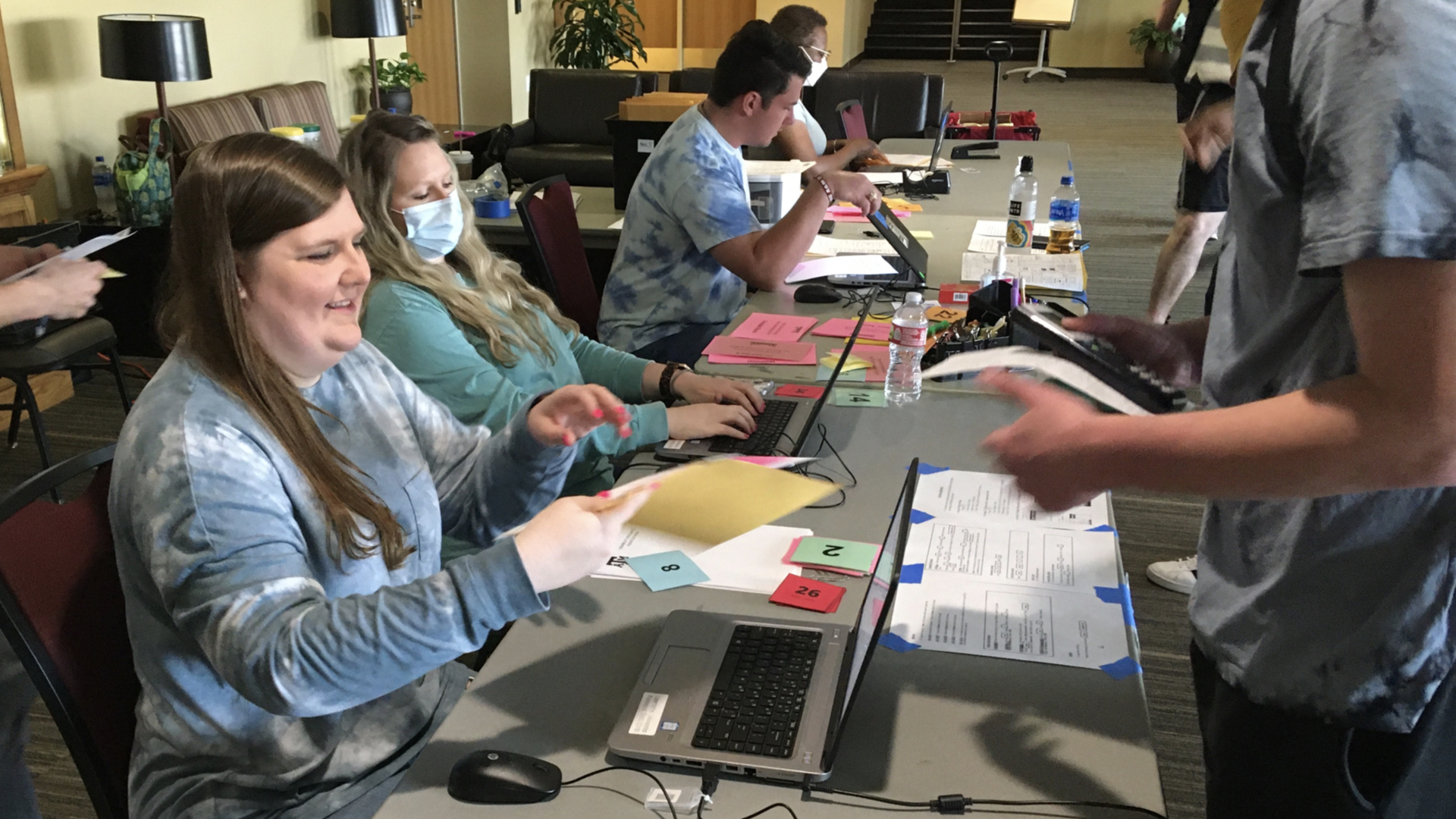
The Disability Resources staff administered 2,233 final exams in May 2022 using AIM software.
Federal data indicates only 34% of students with disabilities finish a four-year degree within eight years, a rate far lower than their peers. Disability Resources (DR) staff work relentlessly to defy those odds and to enable equity at Texas A&M University. Just as they serve as a committed resource for students, Technology Services – Student Affairs has been a determined resource for the DR staff as they tackle the growing challenge together.
The Growing Challenge
DR assigns an access coordinator to every student who requests accommodations. The number of students registering for accommodations is increasing by 10% each year. This spring 3,000 students requested accommodation letters. DR staff members who serve primarily as access coordinators have caseloads of 500 to 700 students whom they help identify their needs and how best to meet them. The result is a personalized accommodation letter for each instructor.
Depending on specific accommodations needed, students may also utilize the testing center, assistive technology services, or other resources offered by DR. With just six staff members, the testing center is challenged as the number of exams administered also grows at a rate of 10% each year. DR administered 10,400 exams this spring, 2,233 of them during finals week.
Imagine being a member of the testing center staff who, by dividing the load, is personally responsible for administering more than 1,730 tests during the semester. The work includes contacting instructors across campus, sometimes repeatedly, asking them to provide the necessary exam on time, clarifying what options are permissible for the test (open book, open notes, calculator, formula sheet, etc.), arranging to pick up each exam if the instructor doesn’t want to drop it off, checking each student in at the right time with the right materials, and keeping exams secured throughout the process until they are returned to the instructor. Next spring you will personally need to repeat this for 1,900 exams. The workload is non-stop and growing, and it cannot be done without help.
A Time for Change
For years, the DR team used a custom application to keep track of the students they serve. What it did, it did well, but they needed more. DR submitted a request to add an instructor portal to the application. The portal would help access coordinators and testing center staff by letting instructors directly submit and retrieve information and tests rather than require students and staff to manually write emails and and carry documents between offices.
The proposed changes would further reduce the burden on students who already have more than average barriers to academic success.
Unfortunately, a project of this size would have to wait until software developers completed another multi-year project. However, Technology Services – Student Affairs offers professional services that can help find and implement other solutions in cases like this. DR knew their peers at other institutions and reached out to them to learn how they managed the workload. Although DR staff did not have the capacity to investigate other options, it provided a starting point for DoIT.
In Need of a Champion
Jill Stickler, a business analyst in DoIT, was excited by the prospect of helping DR. She frequently attends their training workshops. She gushes about the demanding work DR staff do to help so many students. She saw the risk of burnout by staff members who too often had to work overtime. She recognized an opportunity to serve students by helping the DR staff, and she wanted them to have tools to support the level of excellence expected of them.
DR staff members are widely recognized in their field. They have served in leadership roles for the Association on Higher Education And Disability (AHEAD) at both national and state levels, the Texas Governor’s Committee on People with Disabilities, and the Texas Society of Interpreters for the Deaf.
In her role as a business analyst, Jill gathered requirements, arranged demonstrations of vendor products used by peer institutions, and facilitated a decision by DR to select the Accessible Information Management (AIM) system, which many other SEC universities and other institutions use. She worked to get price quotes from the vendor and developed a sole-source justification. She was just getting started when the contract was signed.
The implementation schedule was aggressive. It was a challenge to bridge the gaps between the application’s design, DR’s needs, and the university’s data security requirements. It required coordination between multiple campus IT groups to implement six different data feeds and integrate authentication services.
A final step was to migrate data from the existing custom application. DR polled other schools and consistently heard that others were manually transferring data into AIM, having experienced a range of issues that made scripted transfer difficult. The outlook did not look promising for Texas A&M. However, a Technology Services – Student Affairs developer succeeded where others had failed in scripting the transfer of virtually all existing data and files. The DR staff were pleased with the completeness and accuracy of the migrated student data.
Since Jill doubled as the project manager, perhaps her greatest contribution was facilitating communication. By the completion of the project, she had managed more than 2,200 emails. Despite the tight schedule, she got the “go live” date moved up to better fit the business cycle as the fall term approached.
A New Chapter
As the DR staff prepared to go live with AIM, they wrestled with configuring it to align with their business processes. What they discovered is an axiom for others embarking on similar paths to implement new technology. These are opportune times to re-evaluate existing business processes.
Maria Ortega, an assistant director, has worked in DR for 20 years. She oversees the testing center and serves as an access coordinator. “We have had growing pains,” she said. “We have learned what not to do. We were trying to make AIM fit our process. You must start every process over. Once we started doing that, it worked much better.”
Some of the process changes had nothing to do with the AIM software. Separating tasks across multiple people streamlined the exam check-in process. It all adds up to an improved experience for everyone.
Texas A&M is AIM’s largest client. No one else is doing it at the same level. “AIM has been the only reason we have been able to keep up with the volume in a way that is not reducing service being delivered to students,” said Maria. “Despite the immense case load, I like to think we still have that personalized service. AIM lets us reduce the paperwork required so we can be more available to students.”
A Reason to Cheer
The week of final exams this spring served as a moment of truth for the new processes. Despite administering a record number of exams leading to a hiccup or two as students waited to receive their testing seat assignments, staff members were able to smile as they served students. Instructors also settled in to accepting the new way of doing things as nearly 1,300 of them accessed the portal this spring. They could immediately get information about students needing accommodation in their classes and receive completed exams.
More important, the students noticed a difference. One student checking in for a final exam exclaimed, “The check-in process is much more efficient than in the past, and I’ve been doing this for four years.”
Most important is the question: Is DR’s effort resulting in student success? After the federal government released disappointing national graduation rates for students with disabilities, Texas A&M did its own study. Whereas the national rate is 16% lower than their non-disabled peers after eight years, the graduation rate of Aggie students with disabilities is only 6% less at six years. There is still work to be done, but with better tools and processes, the DR staff will remain relentless.
Achieving value for our customers. That’s what we’re about. Ask how we can help you!
To learn more, watch for upcoming free monthly sessions of the “Accessibility in Aggieland Webinar Series”


